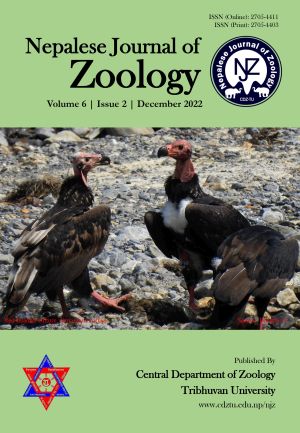Wildlife road-kills on the Tikauli section of East-West Highway in Barandabhar Corridor Forest, Chitwan, Nepal
DOI:
https://doi.org/10.3126/njz.v6i2.51878Keywords:
Biological corridor; Kernel density estimation; Vulnerable species; Wildlife vehicle collisionsAbstract
Roads are one of the linear infrastructures that play important role in nation development. Roads create barrier for the movement of wildlife, however, their impacts on wildlife are not sufficiently studied in Nepal. Thus, current study attempted to explore the impacts of Tikauli section of East-West Highway of Nepal on the wildlife of Barandabhar Corridor Forest (BCF). Wildlife vehicle collisions (WVCs) were recorded from December 2019 to September 2020 by dividing a day into morning, day, and late evening periods. Primary data were collected through direct road survey and key informant interview (n = 22) whereas secondary data were collected from the annals of Chitwan National Park, National Trust for Nature Conservation-Biodiversity Conservation Center and Division Forest Office, Chitwan, Nepal. Arc GIS 10.5 was used to produce relevant illustration and WVC hotspot identification based on Kernel Density Function. Out of thirty-three dead animals observed during the study period, spotted deer (Axis axis) were killed most frequently (n = 11) from WVCs followed by the Oriental garden lizard (Calotes versicolor). The highest number of deaths were recorded in winter and in the late evening. Besides keeping track of WVC records properly, further research is recommended.
Downloads
Downloads
Published
How to Cite
Issue
Section
License
Copyright (c) 2022 Pushpa Rana Magar, Jhamak Bahadur Karki, Lilu Kumari Magar, Sandesh Bolakhe, Nripesh Kunwar

This work is licensed under a Creative Commons Attribution-NonCommercial 4.0 International License.
This license enables reusers to distribute, remix, adapt, and build upon the material in any medium or format for noncommercial purposes only, and only so long as attribution is given to the creator.

